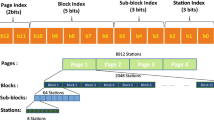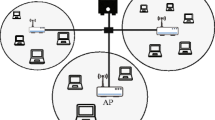Abstract
The problem of allocating resources in IEEE 802.11 wireless local area networks (WLAN) is challenging due to limited bandwidth, time-varying channel conditions, and especially the distributed channel-access manner. In this paper we propose an intelligent resource allocation scheme that dynamically adjusts medium-access-control (MAC) parameters to tune channel-access opportunities and maximize the total utility. “Intelligent” refers to the capability of our approach to regulate each 802.11 node’s parameters automatically according to the changes of surrounding situations, e.g. channel conditions and number of nodes. Our intelligent allocation scheme uses neural networks to on-line learn the nonlinear function between the adopted MAC parameters and allocated throughput. Based on the learned knowledge, MAC parameters can therefore be dynamically adjusted toward the desired throughput allocation and consequently the maximal WLAN utility. Simulations results demonstrate the effectiveness of our allocation scheme in maximizing the system utility in a varying 802.11 WLAN environment.
















Similar content being viewed by others
References
F. P. Kelly. (1997). Charging and rate control for elastic traffic. European Transaction on Telecommunication, January 1997.
Kelly, F. P., Maulloo, A. K., & Tan, D. H. K. (1998). The rate control for communication networks: Shadow prices, proportional fairness and stability. Journal of the Operational Research Society, 409, 237–252.
Song, G., & Li, Y. (2005). Cross-layer optimization for OFDM wireless networks-part I: Theoretical framework. IEEE Transaction on Wireless Communications, 4(2), 614–624.
Song, G., & Li, Y. (2005). Cross-layer optimization for OFDM wireless networks-part II: Algorithm development. IEEE Transaction on Wireless Communications, 4(2), 625–634.
Song, G., & Li, Y. (2005). Utility-based resource allocation and scheduling in OFDM-based wireless broadband networks. IEEE Communication Magazine, 43(12), 127–134.
Shah, V., Mandayam, N. B., & Goodman, D. J. (1998). Power control for wireless data based on utility and pricing. In Proceedings of IEEE personal, indoor, mobile radio communications conference, pp. 1427–1432.
Xiao, M., Shroff, N. B., & Chong, E. K. P. (2003). A utility-based power-control scheme in wireless cellular systems. IEEE/ACM Transaction on Networking, 11(2), 210–221.
Song, L., & Mandayam, N. B. (2001). Hierarchical SIR and rate control on the forward link for CDMA data users under delay and error constraints. IEEE Journal on Selected Areas in Communications, 19(10), 1871–1882.
Saraydar, C. U., Mandayam, N. B., & Goodman, D. J. (2001). Pricing and power control in a multicell wireless data network. IEEE Journal on Selected Areas in Communications, 19(10), 1883–1892.
Cao, Y., & Li, V. O. K. (2002). Utility-oriented adaptive QoS and bandwidth allocation in wireless networks. In Proceedings of IEEE ICC 2002, pp. 3071–3075.
Jiang, Z., Ge, Y., & Li, Y. (2005). Max-utility wireless resource management for best-effort traffic. IEEE Transaction on Wireless Communications, 4(1), 100–111.
Bianchi, G., Campbell, A. T., & Liao, R. R.-F. (1998). On utility-fair adaptive services in wireless networks. In Proceedings of 6th international workshop quality of service, pp 256–267.
Bianchi, G., & Campbell, A. T. (2000). A programmable MAC framework for utility-based adaptive quality of service support. IEEE Journal on Selected Areas in Communication, 18(2), 244–255.
Gao, X., Nandagopal, T., & Bharghavan, V. (2001). Achieving application level fairness through utility-based wireless fair scheduling. In Proceeding of IEEE Globecom 2001, pp. 3257–3261.
Curescu, C., & Nadjm-Tehrani, S. (2005). Time-aware utility-based resource allocation in wireless networks. IEEE Transaction on Parallel and Distributed Systems, 16(7), 624–636.
Kuo, W.-H., & Liao, W. (2007). Utility-based resource allocation in wireless networks. IEEE Transaction on Wireless Communications, 6(10), 3600–3606.
IEEE 802.11a/b, Wireless LAN Medium Access Control (MAC) and Physical Layer (PHY) Specifications, Standard, IEEE, Aug. 1999.
IEEE 802.11e/D5.0, Draft Supplement to Part 11: Wireless Medium Access Control (MAC) and Physical Layer (PHY) specifications: Medium Access Control (MAC) enhancements for Quality of Service (QoS), June 2003.
Liu, W., Lou, W., Chen, X., & Fang, Y. (2003). A QoS-enabled MAC architecture for prioritized service in IEEE 802.11 WLANs. In Proceeding of IEEE GLOBECOM 2003, pp. 3802–3807.
Tinnirello, I., Bianchi, G., & Scalia, L. (2004). Performance evaluation of differentiated access mechanisms effectiveness in 802.11 networks. In Proceeding of IEEE GLOBECOM 2004, pp. 3007–3011.
van der Schaar, M., & Shankar, N. S. (2005). Cross-layer wireless multimedia transmission: Challenges, principles, and new paradigms. IEEE Wireless Communications, 12(4), 50–58.
Shenker, S. (1995). Fundamental design issues for the future internet. IEEE Journal on Selected Areas in Communication, 13(7), 1176–1188.
Hornik, K., Stinchcombe, M., & White, H. (1989). Multilayer feedforward networks are universal approximators. Neural Networks, 2(5), 359–366.
Shen, S., Chang, C.-J., & Wang, L.-C. (2009). A cellular neural network and utility-based radio resource scheduler for multimedia CDMA communication systems. IEEE Transactions on Wireless Communications, 8(11), 5508–5519.
Bigus, J. P. (1998). Adaptive resource allocation using neural networks, US Patent, 1998.
Walczak, S. (1998). Neural network models for a resource allocation problem. IEEE Transactions on Systems, Man, and Cybernetics. Part B, Cybernetics, 2(2), 276–284.
Irie, B., & Miyake, S. (1988). Capabilities of three-layered perceptrons. In Proceedings of the IEEE international conference on neural networks, pp. 641–648.
Cybenko, G. (1989). Approximation by superpositions of a sigmoidal function. Mathematics of control. Signals and Systems, 2, 303–314.
Funahashi, K. (1989). On the approximate realization of continuous mappings by neural networks. Neural Networks, 2, 183–192.
Haykin, S. (1999). Neural networks: A comprehensive foundation (2nd ed.). Upper Saddle River: Prentice Hall.
van der Schaar, M., Krishnamachari, S., Choi, S., & Xu, X. (2003). Adaptive cross-layer protection strategies for robust scalable video transmission over 802.11 WLANs. IEEE Journal on Selected Areas in Communications, 21(10), 1752–1763.
Rappaport, T. S. (2002). Wireless communications principles and practice. Upper Saddle River: Prentice Hall PTR.
Sadeghi, B., Kanodia, V., Sabharwal, A., & Knightly, E. (2002). Opportunistic media access for multirate ad hoc Networks. In Proceeding of ACM MOBICOM, pp. 24–35.
Yin, J., Wang, X., & Agrawal, D. P. (2004). Optimal packet size in error-prone channel for IEEE 802.11 distributed coordination function. In Proceedings of IEEE WCNC 2004, pp. 1654–1659.
Schurmann, F., Hohmann, S., Schemmel, J., & Meier, K. (2002). Towards an artificial neural network framework. In Proceeding of the NASA/DOD conference on evolvable hardware, pp 266–273.
Ahn, C. W., & Ramakrishna, R. S. (2004). Qos provisioning dynamic connection-admission control for multimedia wireless networks using a hopfield neural network. IEEE Transactions on Vehicular Technology, 53(1), 106–117.
Cun, Y. L., Denker, J. S., & Solla, S. A. (1990). Optimal brain damage. In D. S. Touretzky (Ed.), Advances in neural information processing systems, vol. 2, pp 598–605.
IEEE 802.11n, Wireless LAN Medium Access Control (MAC) and Physical Layer (PHY) Specifications: Enhancements for Higher Throughput, 2009.
Bellalta, B., Barcelo, J., Staehle, D., Vinel, A., & Oliver, M. (2012). On the performance of packet aggregation in IEEE 802.11ac MU-MIMO WLANs. IEEE Communications Letters, 16(10), 1588–1591.
Wang, C., & Lin, T. (2008). On throughput performance of channel inequality in IEEE 802.11 WLANs. IEEE Transactions on Wireless Communications, 7(11), 4425–4431.
Modiano, E. (1999). An adaptive algorithm for optimizing the packet size used in wireless ARQ protocols. Wireless Networks, 5(4), 279–286.
Qiao, D., Choi, S., & Shin, K. G. (2002). Goodput analysis and link adaptation for IEEE 802.11a wireless LANs. IEEE Transaction on Mobile Computing, 1(4), 278–292.
Zhu, H., Li, M., Chlamtac, I., & Prabhakaran, B. (2004). A survey of quality of service in IEEE 802.11 networks. IEEE Wireless Communications, 11(4), 6–14.
Acknowledgments
This work was supported in part by Taiwan National Science Council under Grants 101-2221-E-003-016 and 102-2221-E-003-002.
Author information
Authors and Affiliations
Corresponding author
Rights and permissions
About this article
Cite this article
Wang, C., Kuo, WH. A utility-based resource allocation scheme for IEEE 802.11 WLANs via a machine-learning approach. Wireless Netw 20, 1743–1758 (2014). https://doi.org/10.1007/s11276-014-0708-z
Published:
Issue Date:
DOI: https://doi.org/10.1007/s11276-014-0708-z




